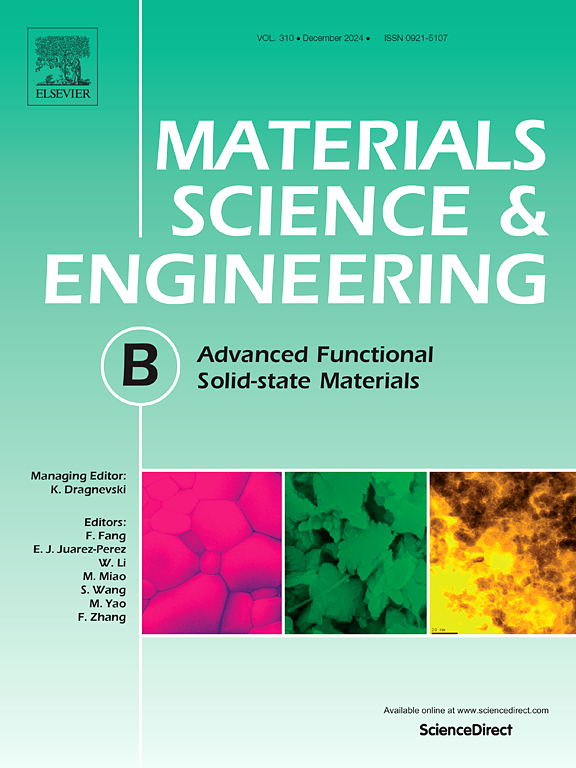Fabrication of white light emitting SrMoO4: Dy3+ nanophosphors: Photoluminescence, ultrasensitive detection in electrochemical sensing, photocatalytic and advanced forensic applications
IF 4.6
3区 材料科学
Q2 MATERIALS SCIENCE, MULTIDISCIPLINARY
引用次数: 0
Abstract
In the present investigations Sr1-xMoO4:xDy3+ (0.00 ≤ x ≤ 0.09) nanopowders were fabricated via simple solution combustion technique. The nanopowders (NPs) were characterized to study their structural, morphological and luminescence properties in detail. From powder X-ray diffraction (PXRD) studies it was found that, the compounds have a space group of I41/a with tetragonal phase. The photoluminescence (PL) results showed two main emission bands which corresponds to 4F 9/2 → 6H 15/2 and 4F 9/2 → 6H 13/2 transitions. The powders emit intense white colour under near Ultra-Violet (nUV) excitation wavelength. The chromaticity color diagrams were studied in detail. The CIE chromaticity coordinates were found to be in the white region indicates that current phosphors were efficiently used in the fabrication of white light emitting diodes (WLEDs). When exposed to UV light, the sample (SrMoO4) doped with Dy3+ (5 mol%) exhibited superior photocatalytic activity of fast orange dye with 97.5 % degradation in 90 min. Also, the powders were evaluated for their excellent electrochemical sensing applications. An increase in lead concentration led to an augmented current, according to the electrochemical measurement of lead. Further, the use of Sr1-xMoO4:xDy3+ (x = 5 mol%) powder as a dusting agent in fingerprint applications was demonstrated on various substrate surfaces. The obtained overall results suggest that, the synthesized NPs can be efficiently utilized in the display device fabrications, superior electrode lead selective substance in electrochemical sensing, as an efficient photo catalyst in dye degradation and also in the advanced forensic applications.

白光SrMoO4: Dy3+纳米荧光粉的制备:光致发光、电化学传感中的超灵敏检测、光催化和高级司法应用
本文采用简单溶液燃烧法制备了Sr1-xMoO4:xDy3+(0.00≤x≤0.09)纳米粉体。对纳米粉体(NPs)进行了表征,详细研究了其结构、形态和发光性能。通过粉末x射线衍射(PXRD)研究发现,化合物的空间基为I41/a,具有四方相。光致发光(PL)结果显示了4f9 /2→6h15 /2和4f9 /2→6h13 /2两个主要发射带。该粉末在近紫外(nUV)激发波长下发出强烈的白色。对色度色图进行了详细的研究。CIE色度坐标位于白色区域,表明电流荧光粉在白光二极管(wled)的制造中得到了有效的应用。当暴露在紫外光下时,掺杂Dy3+ (5 mol%)的样品(SrMoO4)在90 min内表现出优异的快速橙色染料的光催化活性,降解率为97.5%。此外,该粉末还被评价为具有优异的电化学传感应用。根据铅的电化学测量,铅浓度的增加导致电流的增强。此外,Sr1-xMoO4:xDy3+ (x = 5 mol%)粉末作为指纹应用的粉尘剂在各种衬底表面进行了演示。综上所述,合成的NPs可以有效地应用于显示器件的制造、电化学传感中优越的电极铅选择物质、染料降解中的高效光催化剂以及先进的司法应用中。
本文章由计算机程序翻译,如有差异,请以英文原文为准。
求助全文
约1分钟内获得全文
求助全文
来源期刊

Materials Science and Engineering: B
工程技术-材料科学:综合
CiteScore
5.60
自引率
2.80%
发文量
481
审稿时长
3.5 months
期刊介绍:
The journal provides an international medium for the publication of theoretical and experimental studies and reviews related to the electronic, electrochemical, ionic, magnetic, optical, and biosensing properties of solid state materials in bulk, thin film and particulate forms. Papers dealing with synthesis, processing, characterization, structure, physical properties and computational aspects of nano-crystalline, crystalline, amorphous and glassy forms of ceramics, semiconductors, layered insertion compounds, low-dimensional compounds and systems, fast-ion conductors, polymers and dielectrics are viewed as suitable for publication. Articles focused on nano-structured aspects of these advanced solid-state materials will also be considered suitable.
 求助内容:
求助内容: 应助结果提醒方式:
应助结果提醒方式:


